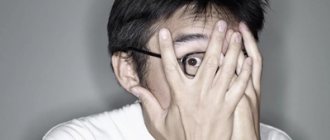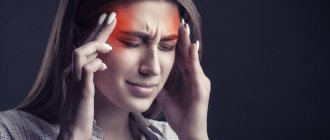This disorder is very common, affecting (to varying degrees of severity) 5% of the world's population. It usually accompanies OCD, neurosis, psychasthenia, and is present in half of patients with mental and neurological diseases. As for the “age qualification”, these are people from 25 to 45 years old, most of whom are women.
Types of anxiety-phobic disorder
Currently, more than five hundred phobias have been studied. Experts have divided them into three broad groups: specific (simple), social phobias, and agoraphobia.
Simple phobias
These include fear of an action, situation, or object. This could be a fear of the dark, certain animals (dogs, spiders, snakes, insects), openings, air travel, darkness, enclosed spaces, blood, heights, disease, etc.
As a rule, such absurd fears develop in a small child during the period when he begins to explore the world. For some people they disappear as they grow up, while for others they remain for the rest of their lives.
Social phobias
People suffering from them are afraid of attention from others and negative evaluation of what they do. Therefore, such individuals try to avoid public speaking, being in society, parties, crowded places, answering at the blackboard at school or university, calling unfamiliar subscribers, etc. This phobia usually develops during adolescence.
Social phobes fear that outsiders will seem ridiculous, inadequate, and strange. They are also concerned about their own reaction to anxiety: voice trembling, facial flushing, hand trembling, nausea.
Agoraphobia
This is the fear of being in a situation from which it is difficult to get out or where help cannot be provided in a timely manner. It appears in people after 20 years of age.
Agarophobes are afraid to go to a store, theater, cinema, travel in public transport, a car and an elevator, be left alone in an apartment, be away from home, in open spaces. As the disorder progresses, it expands its boundaries, that is, there are more and more disturbing situations, and as a result, the person, trying to avoid them, becomes a recluse.
In addition to phobias, anxiety-phobic disorders include pathologies that have pronounced behavioral and cognitive symptoms, with a strong reaction of the body to fear.
- panic attacks;
- generalized anxiety disorder;
- attacks of the Da Costa syndrome type.
Phobic disorders
Common symptoms of phobic disorders are intense acute fear when confronted with the object of the phobia, avoidance, anticipatory anxiety, and awareness of the irrationality of one's own fear. Fear upon contact with an object provokes some narrowing of consciousness and is usually accompanied by violent vegetative reactions. A patient with a phobic disorder completely focuses on the frightening object, to one degree or another ceases to monitor the environment and partially loses control over his own behavior. Increased breathing, increased sweating, dizziness, weakness in the legs, palpitations and other vegetative symptoms are possible.
The first encounters with the object of a phobic disorder provoke a panic attack. Subsequently, the fear worsens, exhausts the patient, and interferes with his normal existence. In an effort to eliminate unpleasant sensations and make life more acceptable, a patient with a phobic disorder begins to avoid frightening situations. Subsequently, avoidance is reinforced and becomes a habitual pattern of behavior. Panic attacks stop, but the reason for their cessation is not the disappearance of the phobic disorder, but the lack of contact with the object.
Anticipation anxiety is manifested by fear when imagining a frightening object or realizing the need to get into a situation of contact with this object. Erased vegetative reactions arise, thoughts appear about intolerance to such a situation; a patient suffering from a phobic disorder plans actions to prevent contact. For example, a patient with agoraphobia, if necessary to visit a large shopping center, thinks through alternative options (visiting small stores selling similar goods); a patient with claustrophobia, before visiting an office located on the upper floors of a building, finds out whether there are stairs in this building that can be used instead elevator, etc.
Patients with phobic disorders are aware of the irrationality of their own fears, but ordinary rational arguments (their own and those of others) do not influence the perception of a frightening object or situation. Some patients, forced to regularly be in frightening situations, begin to take alcohol or sedatives. With phobic disorders, the risk of developing alcoholism, dependence on tranquilizers and other drugs increases. Debilitating fear and restrictions in social, professional and personal life often provoke depression. In addition, phobic disorders are often combined with generalized anxiety disorder and obsessive-compulsive disorder.
Features and risk group
In a patient with this neurotic disorder, only some aspects of mental activity are affected, while his personality does not suffer. Such a person’s thinking is quite normal, there are no hallucinations, delusions, or psychoses. He is clearly aware of his pathology, but he cannot do anything: he is constantly nervous, worried, and does not feel safe.
This discomfort significantly affects the entire life of an individual, preventing him from existing normally in society, from working, studying, relaxing, and realizing himself creatively.
Anxiety-phobic disorder affects people with neuroses, a choleric type of character, who are unable to overcome stress. The large proportion of women in statistics is due to the fact that hormonal surges during pregnancy and the postpartum period can push them towards it. Hormonal changes can affect children during puberty in the same way.
Another option is the influence of parents. For example, the child of a woman who was terribly afraid of cockroaches and demonstrated this at every “meeting” with them, will also have this attitude towards these insects.
People who are suspicious, irritable, and dependent on other people’s opinions are also at risk.
Causes of anxiety-phobic disorder
Often the patient cannot find an explanation for the occurrence of a phobia. In some cases, simple fear is rooted in events previously experienced by a person. Claustrophobia (fear of enclosed spaces) can develop if, as a child, a person was locked in a closed room for some time. In some cases, the cause of anxiety-depressive disorder is family history.
Children often “learn” their fears from family members who suffer from anxiety and depression. The causes of complex phobias, such as agoraphobia (fear of open spaces) or social phobia (fear of being in a public place or speaking in public), are not clear. They can develop in patients prone to anxiety. Agoraphobia can appear immediately after an unreasonable attack of fear. In some patients, the trigger for the appearance of the first symptoms of a phobia and the cause of fear of similar circumstances is a stressful situation. Anxiety-phobic syndrome is often observed in diseases of internal organs.
Causes
As is the case with most mental illnesses, experts cannot name the exact reasons for the development of anxiety-phobic disorder. But we can definitely say that a whole complex of factors contributes to this:
- Heredity. Very often, the patient’s family history contains ancestors with a tendency to excessive uncontrolled reactions to any stimulus, neurotic deviations. This allows us to assert that such pathology can be transmitted by genes with inherent disturbances in the biochemical processes occurring in the central nervous system.
- Personality characteristics - vulnerability, tendency to depression, suspiciousness, anxiety, suspicion, inability to deal with stress. People with this type of character and temperament depend on the opinions of others, are not confident in themselves, and do not like criticism. Their habit is to analyze the situation for a long time and fixate on internal sensations. They consider even very small changes dangerous.
- Depression, neurosis, hypochondria, developing against the background of long loneliness, seclusion, loss of a loved one, separation from a loved one.
- Features of education. The child “absorbs” the specifics of the parents’ behavior and develops a similar algorithm for responding to a stressful situation. If his close relatives focus on a certain irritant and are afraid of it, then the baby will have the same depth of feelings about the same object or situation. Punishment, family conflicts, poor financial condition, and the death of a parent also make a negative contribution to the formation of phobias.
- Hormonal “shake-up” of the body - puberty, pregnancy, postpartum period.
- Violation of the production of mediators and their exchange. A deficiency of biologically active substances leads to severe abnormal fear, among other neurotic reactions.
- Use of psychotropics, narcotic substances, alcoholic beverages, smoking (nicotine has stimulating properties).
- Chronic diseases. This factor still has the status of a hypothesis, but it deserves recognition. With glycemia, a person experiences obsessive fear, anxiety for no apparent reason, agitation, and irrational anxiety. These are symptoms of an anxiety-phobic disorder. Almost the same thing happens with excessive secretion of thyroid hormones, pheochromocytoma (tumor of the adrenal medulla). Panic attacks are also common in patients with mitral valve prolapse.
What symptoms indicate phobic neurosis?
- Patients try to avoid phenomena, objects, conversations that directly or indirectly remind them of their fear.
- Phobic neurosis can manifest itself in various forms. So, with agoraphobia, the patient will be afraid to be in crowded places, in open spaces. Other forms of the disease are also possible. The most common:
- acrophobia - fear of heights;
- claustrophobia - fear of closed spaces;
- nosophobia - fear of contracting a fatal disease;
- social phobia - fear of social contacts;
- thanatophobia - fear of death.
- With various forms of phobic neurosis, a person tries to compensate for the influence of obsessions. Then compulsions (rituals) appear, designed to alleviate negative thoughts. A person with this form of phobic neurosis can check many times whether he closed the front door before leaving, whether he turned off the light. Almost always the ritual is accompanied by counting the number of actions performed. In severe cases, a person may spend hours washing their hands or closing/opening a cabinet door and eventually not even leaving the house. It is worth noting that compulsions can manifest themselves not only as actions, but also as compensatory thoughts aimed at combating obsessive fear.
- Panic attacks are sudden attacks of severe anxiety. Accompanied by lack of air, rapid heartbeat, and fear of dying. The patient's seizures are not controlled.
Treatment of neuroses
Symptoms
It is worth recalling once again that with anxiety-phobic disorder, symptoms appear when getting into a situation or encountering an object of fear, and even when thinking about them.
The most common manifestation is a panic attack . Anxiety quickly rolls over a person, he is gripped by the fear of death, feels a physical catastrophe, is afraid of going crazy, and completely loses control over himself. The pressure rises, the heart beats quickly, there is not enough air, unbearable compression and pain arise in the chest. You sweat profusely, your muscles become weak, you feel dizzy, your gait becomes unsteady, you lose your balance, your stomach gets upset, you want to go to the toilet. All this lasts a few minutes.
Other symptoms are similar to manifestations of Da Costa syndrome (another name is cardiophobia) , which is characterized by attacks similar to severe heart and vascular diseases. The individual experiences what is called animal fear, accompanied by intense vegetative manifestations. The heart rhythm becomes erratic, blood pressure jumps, breathing is disrupted, and there is severe pain in the chest.
Neurotic disorder also exhibits symptoms of generalized anxiety disorder . The patient experiences an incomprehensible anxiety that is not associated with any circumstances. He is constantly tense, unable to relax, and afraid of something. It is difficult for him to fall asleep, and if he does, the sleep is restless, with nightmares and frequent awakenings, during which the anxiety becomes simply unbearable.
Irrational fear and the accompanying reactions of the autonomic system lead to the fact that a person begins to avoid places where he may have an attack. Even if accompanied by someone, he cannot afford to go there. In order to prevent ending up in such a place, the individual develops a special strategy: he makes a detour route, does not use public transport, does not use the elevator, leads a reclusive life if he is afraid of the crowd, or, conversely, strives to be in it if he is afraid of loneliness.
The patient consciously shrinks his social circle, does not want to be in society, and is unable to set goals and achieve them. He cannot concentrate due to unpleasant internal disturbing sensations, cannot think logically and clearly, his memory fails him.
As a result: problems at work, personal life suffers, its quality, career, etc. And the further it goes, the worse it gets. That is why anxiety-phobic disorders must be treated immediately by contacting specialists. In Moscow they can be found at the City Psychoendocrinological Center (MGPEC).
Don't waste time and go to the doctor if:
- the above symptoms are severe and uncontrollable;
- anxiety does not go away for a long time, even if the stressful situation is far behind;
- fear finds without reason;
- fear and anxiety are accompanied by negative somatic symptoms;
- Anxiety and physical manifestations have a negative impact on personal and social life.
Who most often suffers from this nervous disorder?
Based on my numerous observations as a medical expert, we can conclude that people who live by reason, but not by emotions, are most susceptible to this disease. Before making a decision, they will think through everything, weigh the positive and negative aspects. It is this category of patients that exhibits symptoms such as anxiety, suspiciousness, responsibility, and caution.
Free consultation right now!
Online consultation with a specialist on your issue!
License number: LO-77-01-019036
Those people who can quickly shift responsibility for the current situation onto others rarely suffer from this disorder. They try to achieve their goals in any way, showing aggression and persistence. This disease can become more active at a certain age. This may include adolescence, early adulthood and the years before menopause.
What are the causes of the disease?
The main causes of the disorder are associated with psychological trauma, intensive work, a short period of rest, and constant lack of sleep. The disease can also develop in people who are addicted to alcohol or have had infectious pathologies. In addition, mental health is weakened by diseases such as endocrine system disorders.
Write to WhatsApp
COST OF TREATMENT
What is the violation?
Anxiety-phobic disorder is characterized by a persistent state of fear of contracting some terrible illness. People who seek isolation from society and do not want to be the center of attention are also susceptible to this disease. Such patients often experience panic attacks, agrophobias, social phobias,
Attacks appear suddenly. They last from five minutes to an hour. A person loses control over himself. He lacks air, feels nauseated, and has a rapid heartbeat. Agrophobia manifests itself in the fear of open spaces, fear of crowds. In parallel with this disorder, signs of claustrophobia may occur.
Online consultation with a specialist
regarding your question!
License number: LO-77-01-019036
Social phobias come in many forms. This is the fear of becoming the center of attention of others, painfully accepting negative evaluation, the desire to withdraw from social situations. Such phobias are accompanied by increased sweating, trembling, internal stiffness, a state of shame, and shyness.
Treatment
A doctor - a psychiatrist, psychologist or psychotherapist - diagnoses an anxiety disorder through a conversation with the patient and special questionnaires. He also needs to exclude the presence of diseases not related to the mental state (cardiovascular, neurological, etc.). If they are available, then other specialists will already deal with them.
The mechanism of fear occurrence has now been fully studied. Therefore, treatment of anxiety-phobic disorders, of course, in case of timely access to qualified specialists, has excellent positive results. There are pharmacological and psychotherapeutic methods for this.
Use of drugs
Pharmacological agents are the basis for the treatment of anxiety-phobic disorders. They help relieve acute symptoms of pathology and normalize the patient’s psycho-emotional state. Treatment uses tranquilizers, antidepressants, and sleeping pills. They are prescribed, prescribed and given recommendations for admission exclusively by a psychotherapist or psychiatrist.
1. Antidepressants - treatment begins with their prescription, since they do not act immediately, but after 4-8 weeks. In order not to cause side effects, of which there are many, the doctor first prescribes the drug in small doses, gradually increasing it depending on the patient’s tolerability of the drug.
Information is constantly exchanged between the nerve cells that make up the human brain. The conductor is chemical messengers. They are involved in the formation of feelings of fear, anxiety, and stress, and this happens due to a decrease in the level of neurotransmitters in them - serotonin (“the hormone of happiness”) and an increase in norepinephrine (which has a vasoconstrictor and pressor effect). Antidepressants stabilize their quantity, thereby eliminating anxiety, lowering blood pressure, and calming the heart.
2. Tranquilizers - psychotropic, sedatives that reduce anxiety and anxiety, eliminating panic. Usually these are drugs from the antixiolytic group - benzodiazepines, delicate daytime remedies with a mild and quick action, which are taken in a short course. Their calming effect is due to their inhibitory effect on brain cells and muscle relaxation, which reduces physical stress.
3. Sleeping pills . They are necessary for those patients who suffer from insomnia. Take them for a short period (no more than 4 weeks) right before bed.
All of the above medications have certain side effects, varying degrees of addiction and withdrawal symptoms.
Anxiety disorders (diagnosis and therapy)
About the article
3898
0
Regular issues of "RMZh" No. 15 dated 08/18/2005 p. 1019
Category: General articles
Author: Kolyutskaya E.V.
For quotation:
Kolyutskaya E.V. Anxiety disorders (diagnosis and therapy). RMJ. 2005;15:1019.
Anxiety (anxiety-phobic) disorders are one of the most common variants of borderline mental pathology. According to epidemiological studies, the lifetime prevalence of anxiety disorders (panic disorder, agoraphobia, social phobia) averages 1.5%.
Modern classifications traditionally distinguish the following types of anxiety disorders: panic disorder (regularly recurring attacks of fear accompanied by autonomic disorders), agoraphobia (fear of independent movement), social phobias (a broad group of phobias associated with the fear of being in various social situations). It is necessary to immediately make a reservation that the problem of identifying anxiety disorders is not the exclusive prerogative of psychiatrists. In most cases, patients with developing anxiety disorders first seek help from general medical practitioners. Low awareness of the doctor about the features of recognizing anxiety disorders sometimes leads to diagnostic errors. As a result, patients with panic disorder can be observed for years for non-existent (or minimally expressed) cardiovascular or bronchopulmonary pathology (typical diagnoses are “atypical bronchial asthma”, “vegetative-vascular dystonia”, etc.). Symptoms of social phobia often go completely unaddressed. The pronounced manifestations of this disorder are interpreted by the doctor as manifestations of “ordinary shyness.” A consequence of the low detection of anxiety disorders in general practice is that patients do not receive adequate therapy for a long time, or are not treated at all. Based on the above, it seems important to increase the awareness of general specialists about the features of diagnosis and treatment of anxiety disorders. Anxiety disorders have a complex structure. In addition to acute manifestations of anxiety - panic attacks, other vegetative paroxysms, the structure of the syndrome invariably includes features of “avoidant behavior” (the desire to avoid situations that are fraught with a recurrence of a panic attack or an exacerbation of anxiety). In cases of agoraphobia, this is a fear of independent movement, based on the avoidance of situations where the patient may be left without help; in cases of social phobias, this is the avoidance of certain social contacts. It is the presence of persistent phobic avoidance of certain situations that is the basis for diagnosing mental pathology in this circle. The category of anxiety disorders traditionally includes conditions of varying severity. Typically, the main marker of the severity of anxiety disorders is the persistence of avoidant behavior, as well as the number of phobic situations to which it extends. Thus, an isolated form of social phobia is distinguished, characterized by 1-2 social situations that cause fear and avoidance (for example, public speaking, eating in public places, etc.). In cases of agoraphobia, phobic avoidance can also affect only certain modes of transportation (for example, for residents of large cities, traveling on the subway is the most critical). Isolated forms of anxiety disorders proceed more favorably, both from the point of view of a slight effect on the adaptation of patients, and from the point of view of fairly good sensitivity to therapeutic effects. Thus, in cases of rare panic attacks, only occasionally accompanied by avoidant behavior, relief of acute manifestations of anxiety is sufficient to reduce the symptoms of agoraphobia. However, most anxiety disorders are characterized by a chronic course precisely due to the formation of persistent avoidant behavior, which completely disrupts the patient’s ability to move independently (“panagoraphobia”) or excludes most social contacts (generalized social phobia). Such chronic anxiety disorders lead to severe social maladaptation of patients, including permanent disability. Features of the dynamics of anxiety disorders - the tendency to chronicity and relapse - largely determine the complexity of their treatment. The traditional therapeutic approach, based on the predominant use of anxiolytics (benzodiazepine derivatives), is justified only in cases where the clinical picture is dominated by acute anxiety disorders (for example, uncomplicated panic attacks). In the presence of persistent phobic disorders (agoraphobia, social phobias), monotherapy with anxiolytics is usually ineffective. Since the mid-20th century, antidepressants have been increasingly used in the treatment of anxiety disorders. Numerous studies have shown that the use of classical (tricyclic) antidepressants (amitriptyline, imipramine, clomipramine) gives a more pronounced and lasting clinical effect. Moreover, therapy with antidepressants eliminates the possibility of developing frequent complications when using anxiolytics - changes in tolerance, the formation of drug dependence and withdrawal syndrome. However, this therapy option is associated with many difficulties. The need to use high doses of tricyclic antidepressants during long courses of treatment (six months or more) is largely limited by the side effect profile of these drugs. Undesirable phenomena such as sedation, weakened concentration, and decreased reaction speed cause difficulties in the social and professional spheres: difficulties in learning and intellectual activity, limitations in work that requires speed and accuracy of action (including driving). These circumstances lead to an increased risk of patients’ non-compliance with the prescribed therapy regimen, including refusal to take medications. Attempts to change the intensity of adverse events by reducing drug doses can also lead to patients taking drugs for years in obviously ineffective doses. It is in these cases that the formation of drug resistance is most often observed. It should also be noted that the adequate use of tricyclic antidepressants is impossible in patients with a number of concomitant somatic diseases (severe cardiovascular pathology, prostate diseases, open-angle glaucoma). As a result, antidepressants are used either in doses that are obviously lower than therapeutic ones, or in short courses, which invariably leads to a low therapeutic response and a risk of relapse of anxiety disorders. Antidepressants of the next generations, due to their greater safety, turned out to be more adequate for the treatment of anxiety disorders. Currently, the most commonly used drugs are the selective serotonin reuptake inhibitors: paroxetine, citalopram, fluoxetine, fluvoxamine, sertraline. Selective serotonin reuptake inhibitors, while equally effective as tricyclic antidepressants against anxiety disorders, have a significantly more favorable spectrum of side effects. To date, it has been clinically proven that long-term use of selective serotonin reuptake inhibitors does not lead to a significant change in the social activity of patients and does not require professional restrictions. Drugs in this group have proven themselves to be significantly safer in patients with concomitant somatic diseases: cardiovascular, bronchopulmonary, etc. The absence of anticholinergic effects (characteristic of tricyclic antidepressants) allows the use of selective serotonin reuptake inhibitors in patients with diseases of the urinary system and people suffering from open-angle forms of glaucoma. To date, selective serotonin reuptake inhibitors are first-line drugs in the treatment of anxiety disorders. Selective serotonin reuptake inhibitors are used both as monotherapy and in combination with other medications. In the treatment of panic disorder, the most common use is the combined use of an antidepressant and anxiolytics (benzodiazepine derivatives). The latter are prescribed in short (no more than two weeks) courses to relieve panic attacks. Selective serotonin reuptake inhibitors are used for a long time - at least six months. It should be noted that daily dosages of antidepressants significantly exceed the doses used to relieve depressive disorders. For example, if the average dose of paroxetine (Rexetine) for the treatment of depression is 20–40 mg/day, then in cases of panic disorder the drug is used in a dosage of 40–60 mg/day. (this dosage regimen is also followed when using citalopram and fluoxetine). To prevent relapses of panic disorder (in cases of its chronic course), maintenance therapy is carried out with reduced (usually half) doses of the previously used drug. Psychopharmacotherapy of agoraphobia and social phobias (taking into account their predominantly chronic course) is based on the use of high doses of selective serotonin reuptake inhibitors (up to 80 mg/day when using paroxetine, citalopram and fluoxetine) for a long time - in cases of pronounced avoidance behavior, many years are indicated taking an antidepressant. When therapeutic resistance is established, combination therapy with the inclusion of antipsychotics in the drug regimen is most effective. When choosing an antipsychotic, it is also appropriate to take into account the safety of its use: typical antipsychotics are used in low doses, atypical ones in medium doses. It should be noted that among selective serotonin reuptake inhibitors, not all drugs demonstrate equal effectiveness against anxiety disorders. Thus, antidepressants with a pronounced stimulating effect (for example, fluoxetine) in some cases can increase the severity of acute anxiety disorders (in the first weeks of therapy, an exacerbation of the manifestations of panic disorder is sometimes observed). Based on this, the most optimal drugs to use are balanced drugs, which include paroxetine (Rexetine, pharmaceutical). Many years of experience in using this drug have shown its high anti-anxiety activity even in cases where the clinical picture shows frequent and intense panic attacks. Indications for the use of paroxetine (Rexetine) cover a wide range of syndromes of the affective and neurotic registers. The use of the drug is effective for a wide variety of anxiety disorders of varying severity and generalization. The prescription of adequate high doses of paroxetine (Rexetine) is justified for anxiety-phobic manifestations in the form of so-called “panic attacks”, as well as for obsessive disorders within the framework of obsessive-compulsive syndrome. The effect of Rexetine therapy is found not only in stress-related disorders and endogenous affective diseases, but also as part of complex therapy for neurosis-like and depressive disorders of a schizophrenic nature. The good tolerability and safety of the drug allows us to recommend the administration of paroxetine (Rexetine) to elderly and senile patients in accordance with the indicated indications and to carry out treatment on an outpatient basis. It must be emphasized that the timing of the clinical effect of paroxetine (Rexetine) on different manifestations of the anxiety-phobic symptom complex differs significantly. The intensity of manifestations of panic disorder is significantly reduced by 14–20 days of therapy (depending on the individual sensitivity of the patient and the initial severity of acute anxiety disorders). The effect of the drug on symptoms of avoidant behavior manifests itself at a later date - on average, after 30–40 days of treatment. In patients with social phobias, a reliable anxiolytic effect can be recorded no earlier than a month of therapy. Thus, modern approaches to the treatment of anxiety disorders, regardless of specific therapeutic strategies (mono- or combination therapy), are based on the priority use of antidepressants that have pronounced anti-anxiety activity and are as safe as possible in use.
Content is licensed under a Creative Commons Attribution 4.0 International License.
Share the article on social networks
Recommend the article to your colleagues









